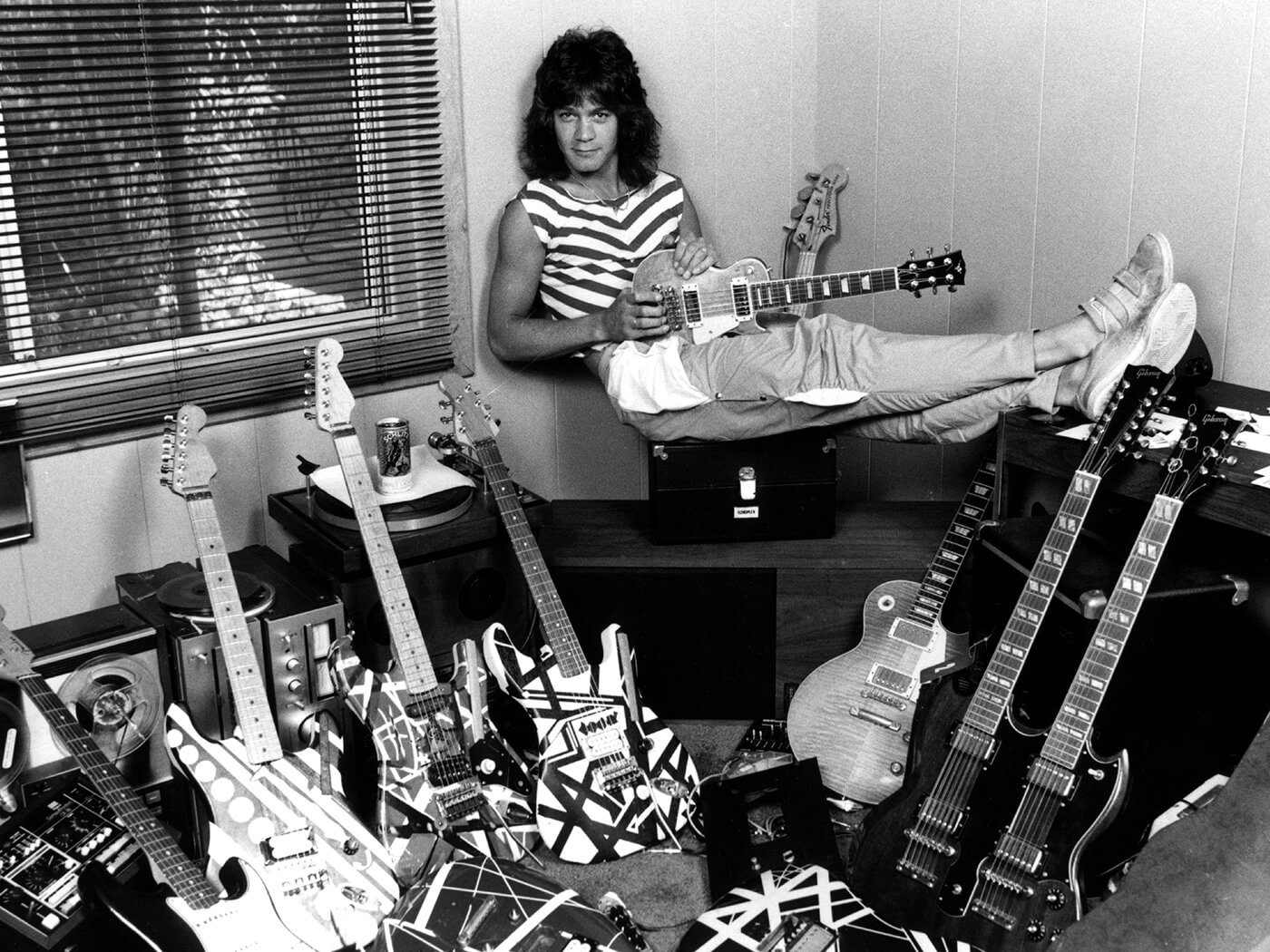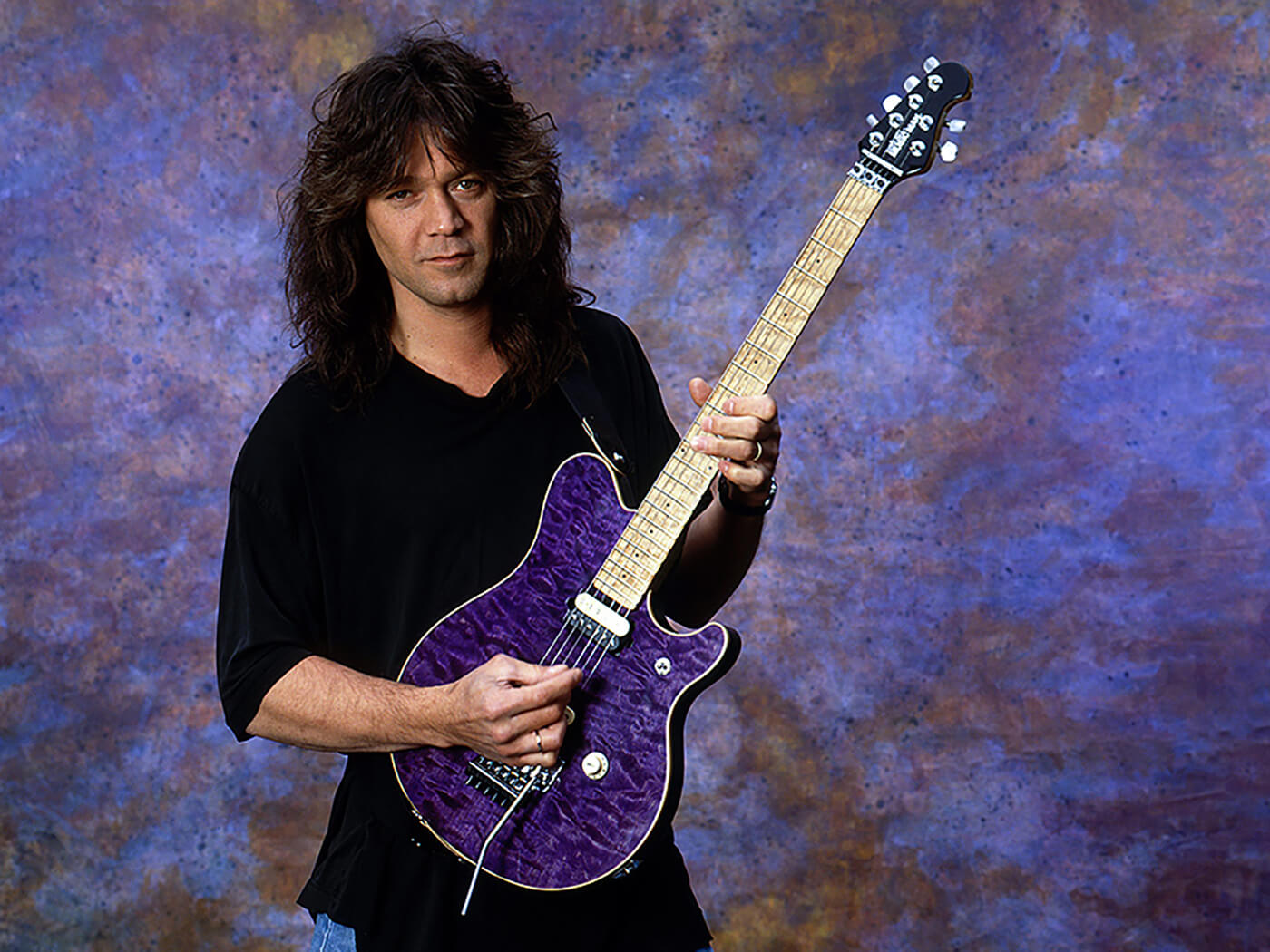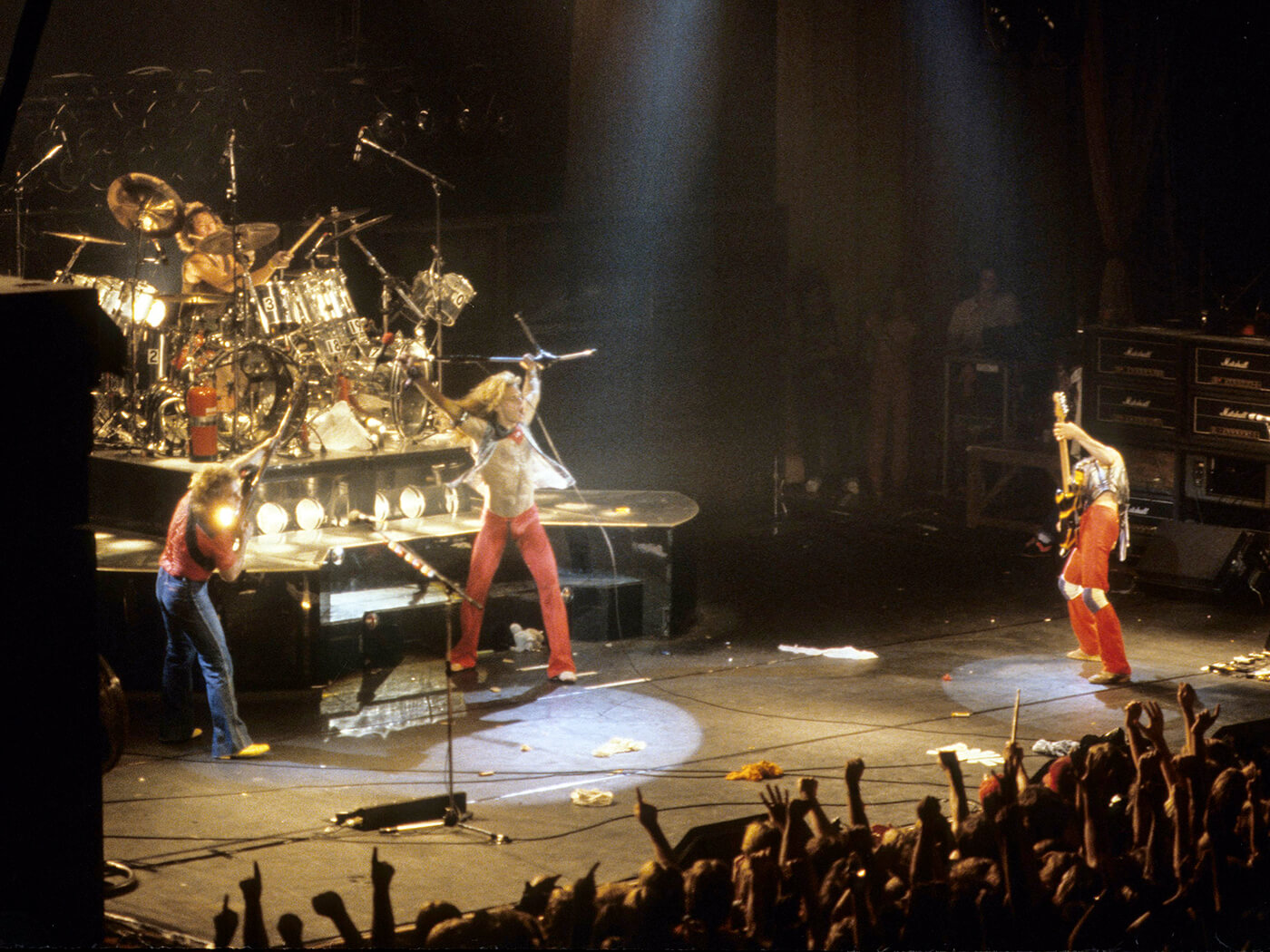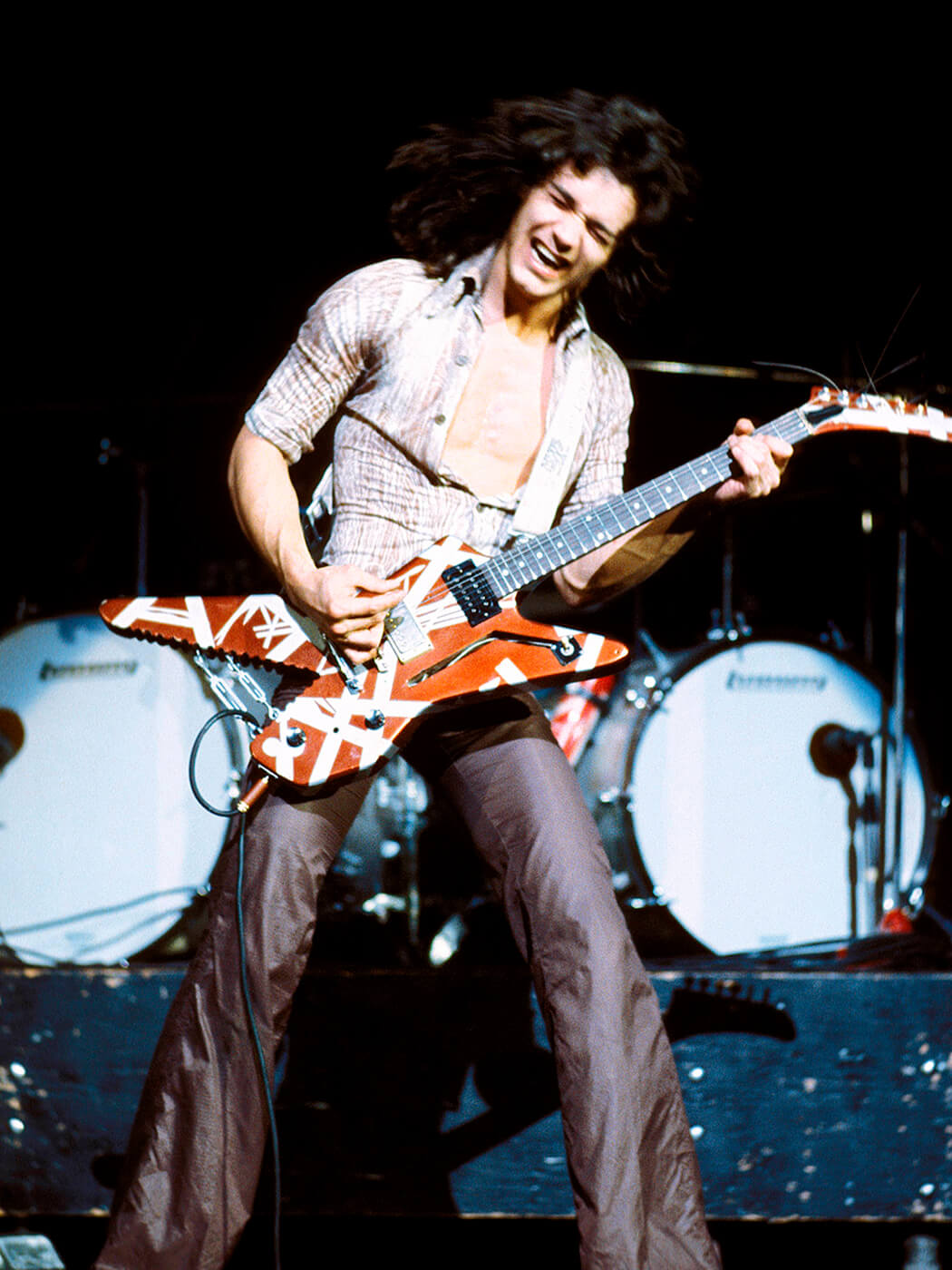How Eddie Van Halen’s “endless pursuit” of perfection changed the guitar industry forever
EVH’s playing was boundary-pushing and his unique approach to gear was equally revolutionary in the 1970s, but his “endless pursuit” of perfection kept him refining and pushing the envelope for the next 40 years, changing the industry along with it.

EVH surveying his guitar collection – which included Strats, Frankenstrats, Les Pauls, and a double-neck Gibson EDS-1275 – from atop his Echoplex. Image: Richard E. Aaron / Redferns / Getty Images
Eddie Van Halen didn’t just amaze his fellow guitarists with the remarkable work he did using a rare combination of playing techniques. Ed’s attitude to his guitars and his amplification also influenced a multitude of musicians, instrument makers, and amp builders.
“I hate store-bought, off-the-rack guitars,” he told Jas Obrecht at Guitar Player back in the late 70s, a few months after the first Van Halen album appeared. “They don’t do what I want them to do.” This summed up the approach Ed took to more or less all the gear he used during the years of his growing success.
He’d started out on a cheap Teisco electric, and some of his mates in early pre-VH bands considered that a Strat he moved to sounded too thin and a 335 looked too un-rock. So he decided to take matters into his own hands and combine some of the qualities of Fender and Gibson into one home-assembled instrument. Enter Frankenstrat, Ed’s generic name for several lashed-up guitars that he put together from assorted parts.
Frankenstein’s monster
As with many things Ed, the stories have varied through the years, but it seems likely that the first Frankenstrat, the one with the black-and-white finish seen on the front of that first Van Halen album cover, consisted of a Strat-style body and neck he got from Charvel, in turn supplied to Charvel by Boogie Bodies. He took the PAF humbucker from his 335 and fitted that to the body, slanted at the bridge. He glued in some jumbo Gibson frets, and he screwed on his Strat’s vibrato and fitted a single control for volume.
Then there was that distinctive black-and-white finish, which Ed achieved using acrylic bicycle paints, spraying on a black base, sticking down apparently random strips of masking tape—spraying white over everything, removing the masking tape, and revealing a fancy striped effect. A later reworking resulted in a red, black, and white look.

The Frankenstrat served him well. In 2011, when Ed donated Frankenstrat 2 to the Smithsonian National Museum of American History, he told the museum’s magazine what became of Frankenstrat 1. “I retired it from regular use,” he said. “It took so much abuse from endless touring and recording—I wanted to pay some respect to it and let it survive and not let it get destroyed completely. At the same time it became something so well-known beyond my wildest dreams that its value made it a target for theft, and I wanted to protect it. I still play it every now and then. It’s priceless to me.”
The next step in the story of Ed’s individually styled guitars came with an endorsement deal that he made with Kramer in 1983. His tie-up would help propel Kramer to become the biggest-selling electric guitar brand in the States during the mid 80s—although in its original form, the company would burn out and barely survive into the following decade.
As well as the production models that he promoted, Ed’s most famous Kramer was a new take on the Frankenstrat, usually called the 5150 thanks to some taped numbers on its body (and named to match Ed’s 5150 recording studio). The guitar centred on a Kramer Pacer Special body and a custom maple neck with hockey-stick head, like the one on a modified Ibanez Destroyer that Ed owned. It had the familiar set of relatively straightforward appointments: single bridge humbucker (straight rather than angled this time), single volume control, Ed’s now favoured Floyd Rose vibrato system, and of course a red, white, and black striped finish.
Ed’s do-it-yourself attitude was hardly new, and players had chopped and changed guitars to suit their requirements for years. But his choices paralleled a growing affection among some makers for mixing Fender and Gibson attributes, and also the rise of the ‘SuperStrat’ – the extreme rocker’s tool of choice that was developed through the 80s thanks not only to Kramer but also to makers such as Electra/Westone, Jackson, Ibanez, and more.

Searching for the brown sound
If you find Ed’s early guitar history confusing, wait till you get to the amps. If you’re after some facts, then you’d best look away now. About all we can say with a hint of certainty is that for those crucial early recordings he used a 60s Marshall Super Lead JTM100 Plexi, with one or two Marshall cabs. Live, he used more Marshalls. There is debate about whether or not the Marshalls were modified, and the short answer is that it depends what you call modified.
At first, Ed used the services of a tech called Jose Arredondo, so if mods were done at that time—maybe a cascading gain here, or an external dummy load there—it was Arredondo who did the modding. Some techs who serviced later amps swear they were stock and un-modded. The legend shows no signs of becoming clearer, and it wasn’t helped by Ed’s own mischievous muddling when discussing his gear history.
It seems safer to consider his earliest comments on the subject, in that interview with Jas Obrecht just after the first album in 1978. He spoke then about Arredondo, about the four “very old” Marshalls he had originally, and about the way Arredondo would “beef them up”. Ed reckoned Arredondo “put bigger transformers” in his Marshalls and that he used a Variac box to change the voltage going into his amps. Variac is a brandname that’s been applied generically to a transformer that will adjust the level of mains voltage going into an amplifier—and some have since noted the potential dangers of this practice.
“The amp’s only supposed to take 100 volts,” Ed said of the American mains feed, “but you crank the thing above that, like to 130, 140 volts, and the tubes really glow.” In the ’78 interview, he said he’d lost those original Marshalls, reporting that on stage he used three 100-watt tops “of whatever make—right now I’m using Music Man, a couple of Laney amps, which are English, and a couple of new Marshalls,” along with two similar sets of backups.

Then there’s Ed’s “brown sound”, his description of the results from his original setup of MXR Flanger, MXR Phaser, Echoplex tape echo, and Marshall amps (and the minor matter of Ed’s head, hands, and heart). He told Obrecht again in a later interview, in 1980: “There is a difference between being just loud, and having what I call a warm, brown sound—which is a rich, toney sound. … I can actually play so loud on stage that you won’t hear anything else, but I don’t really like to do that. I like to get a balanced sound.”
Something of a cottage industry has grown in more recent years for boutique amps that celebrate the timeless attributes of the early Marshalls, and the mythology surrounding Ed’s brown sound has contributed to the trend. Dave Friedman at Friedman Amplification is one of the makers concerned with the modern interpretation of the classic British amp circuits and tones, and he’s been in the business long enough to have seen it all. “To me, the quintessential amp is an old Plexi Super Lead circuit with a Variac, on 10,” he told Dave Hunter in this publication earlier this year. “That’s where my amp head is, which is quite gain-y if it’s set up right—but old-school gain-y. You know, more the Van Halen school of Plexi, shall we say.”
Ed, meanwhile, would continue his quest for the amp sound he was always chasing—brown or otherwise. In later years, he teamed up with Peavey for his first series of 5150 amps, starting in 1992, and more recently there were his various EVH amps, in collaboration with Fender, which kicked off in 2007 with the 5150 III. “What else do I have?” he wondered aloud in that ’78 chat. “I can’t even remember—I’ve got so many different heads! I just got to patch them all together and hope it sounds cool. It’s working out pretty good.”
The Wolfgang cometh
In later life, Ed worked with several guitar companies to produce a sequence of signature models based on a design he called the Wolfgang, named for his son. The first sighting came in 1991 with the Music Man Edward Van Halen model, following Ed’s endorsement in the mid 80s of Ernie Ball 5150 strings, and Music Man’s own introduction of its Silhouette guitar and Steve Morse signature model.
Dudley Gimpel, who designed the Silhouette, teamed up with Ed, and the result marked a distinct change from the earlier Frankenstrat and Kramer instruments. Working from Ed’s original sketches, they developed a basswood body with a flat maple top, a single volume control, and a neck-end wheel truss-rod adjuster. The vibrato was a Gotoh-licensed Floyd Rose, with hardtail option, and Steve Blucher at DiMarzio helped create a custom pair of pickups that convinced Ed to finally go twin. Ed used an amber flame-top example, one of the earliest prototypes, as his main guitar for several years.
He switched to Peavey in the mid 90s as his deal with Music Man ended (although Music Man continued to produce a very similar guitar without the EVH association, the Axis). Jim DeCola was supervisor of guitar design engineering at Peavey, where he’d been since 1988, and Jim and Ed developed prototypes that moved on from the Music Man.

The production Peavey Wolfgang introduced in 1996 added contouring for the maple top, pushed the neck a little deeper into the body, had carbon fibre reinforcement rods in the neck, recessed the truss rod wheel into the end of the neck, and had a new headstock with Ed’s idea for a ‘V’ element matched to Jim’s scooped tip in a recognisable Peavey shape. The pickups were based on a Frankenstrat unit, a tone control was added alongside the volume, and the vibrato was a Ping licensed Floyd Rose, with a D-Tuner on the low E-string.
Ed split with Peavey in 2004, and another revised Wolfgang became part of the line of products for that Fender-related EVH brand, the deal following a run of Ed’s Art Series guitars around 2004 with the Fender-owned Charvel brand. The first sign of EVH guitars came with a limited-edition remake of Ed’s Frankenstrat, and then the brand’s new take of the Wolfgang appeared in 2009, developed with Chip Ellis at Fender.
Agreeing to a set of pickups developed in-house at Fender, Ed was still unsure if the placement was exactly right. “I didn’t have a router with me to enlarge the pickup cavity on the day we decided to look into that,” Chip tells me. “So, Ed went into his garage and grabbed a crowbar and a hammer. We went out in the driveway, and basically he chiseled this huge pocket so we could move the pickup around in it. If you look at pictures of Number 4 prototype on Ed’s ’07/’08 tour, it looks like a dog chewed the pickup cavity. But it did the trick! I believe we ended up moving it a 32nd of an inch, and we found the sweet spot.”
Since the first EVH Wolfgang in 2009, variations on the theme were added alongside, including set-neck and hardtail models, and cheaper guitars made offshore. “I seem to always be refining the design,” Ed told The Hub in 2017. “I’m constantly putzing around with it. You go on tour and you realise what works and what doesn’t work. It’s an endless pursuit.”
Eddie Van Halen never stood still when it came to his guitars and amps. And more often than not, he did it all with a smile on his face. He rarely appeared to take himself too seriously. “I never really sit down and really practice,” he said in ’78, “Like shut myself in a little room and go, ‘All right, I’m serious now.’ You know, I just sit around and whenever I get bored, I play my guitar.”
For more features, click here.
